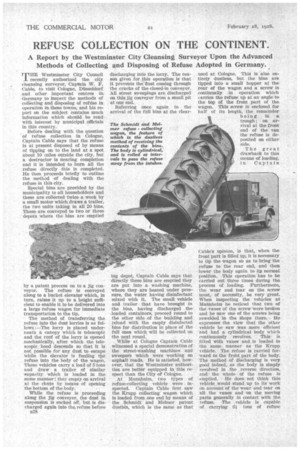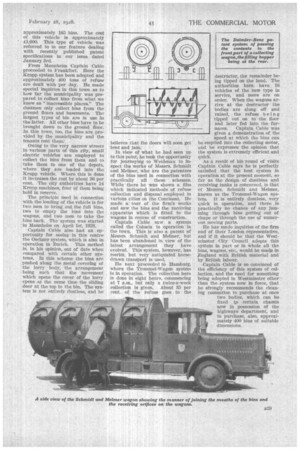REFUSE COLLECTION ON THE CONTINENT.
Page 54

Page 55

If you've noticed an error in this article please click here to report it so we can fix it.
A Report by the Westminster City Cleansing Surveyor Upon the Advanced Methods of Collecting and Disposing of Refuse Adopted in Germany.
TJ1FU Westminster City Council 1. recently authorized the city cleansing surveyor, Captain W. F. Cable, to visit Cologne, Dfisseldorf and other important centres in, Germany to inspect the methods of collecting and disposing of refuse in operation in these towns, and his report on the subject Contains much information which should be read: with interest by municipal officials in this country.
Before dealing with the question of refuse collection in Cologne, Captain Cable says that the refuse is at present disposed of by means of tipping on to the land at a spot about 10 miles outside the city, but a destructor is nearing completion and it N intended to burn all the refuse directly this is completed. He then proceeds briefly to outline the method of dealing with the refuse in this city.
Special bins are provided by the municipality to all householders and these are collected twice a week by a small motor which draws a trailer, the two units taking in all 20 bins. These are conveyed to two or three depots where the bins are emptied by a patent process on to a jig conveyor. The refuse is conveyed along to a bucket elevator which, in turn, raises it up to a height sufficient to enable it to be delivered into a large refuse wagon for immediate transportation to the tip.
The method of transferring the refuse into the dust lorries is as follows :—The lorry is placed underneath a canopy which is telescopic and the roof of the lorry is opened _mechanically, after which the telescopic hood descends so that it is not, possible for any dust to escape 'while the elevator is feeding the refuse into the body of the wagon. These vehicles carry a load of 5 tons and draw a trailer of similar capacity which is loaded in the same manner ; they empty on arrival at the chute by means of opening the bottom of the body.
While the refuse is proceeding along the jig conveyer, the dust in suspension is sucked off, but is discharged again into the, refuse before n2S
discharging into the lorry. The reason given for this operation is that it prevents the-lust coming through the cracks of the closed-in conveyer. All street sweepings are discharged on this jig conveyor from a small pit at one end.
Referring once again to the arrival of the full bins at the clear
ing depot, Captain Cable says that directly these bins are emptied they are put into a washing machine, where they are heated under pressure, the water having disinfectant mixed with it. The small vehicle and trailer that have brought in the bins, having discharged the loaded containers, proceed round to the other side of the building and reload with the empty disinfected bins for distribution in place Of the fall ones which will be collected on -the next round.
While at Cologne Captain Cable witnessed a special demonstration of the street-washing machines and sweepers which were working on asphalt roads. He is satisfied, however, that the Westminster authorities are better equipped in this respect than the City of Cologne.
At Mannheim, two types of refuse-collecting vehicle were inspected. Captain Cable first saw the Krupp collecting wagon which is loaded from one end by means of the Schmidt and Winter patent dustbin, which is the same as that used at Cologne. This is also entirely dustless, but the bins are tipped into a small hopper at the rear of the wagon and a screw is continually in operation which earries the refuse up at an angle to the top of the front part of the wagon. This screw is enclosed for half of its length, the remainder being in a trough ; on arrival at the front end of the van the refuse is deposited on either side.
The great drawback to this means of loading, in Captain
Cable's opinion, is that, when the front part is filled up, it is necessary to tip the wagon so as to bring the refuse to the rear end, and then lower the body again to its normal position. This operation has to be carried out three times during the process of loading. Furthermore, the wear and tear on the screw must, of necessity, be very great. When inspecting the vehicles at Mannheim he noticed that two of the vanes of the screw were broken and he saw one of the screws being rewelded in the shops there. He expresses the view that the other vehicle he saw was more efficient and had a cylindrical body which continuously revolves. This is fitted with vanes and is loaded in the same manner as the Krupp vehicle. The refuse is carried forward to the front part of the body. The method of discharging is very good indeed, as the body is simply revolved in the reverse direction, and the whole of the refuse is emptied. He does not think this vehicle would stand up to its work on account of the wear and tear on all the vanes and on the moving parts generally in contact with the refuse. -The vehicle is capable of carrying 6 tons of refuse
approximately 165 bins. The cost of this vehicle is approximately
1,60o. This type of vehicle was referred to in our feature dealing with recently published patent specifications in our issue dated January 3rd.
From Mannheim Captain Cable proceeded to Frankfort. Here the Krupp system has been adopted and approximately 400 tons of refuse are dealt with per day. He made special inquiries in this town as to how far the municipality was prepared to collect bins from what we know as "Inaccessible places." The dustmen only collect bins from the ground floors and basements. The largest types of bin are in use in the latter. All other bins have to be brought down to the ground ilbor. In this town, too, the bins are provided by the municipality and the tenants rent them:
Owing to the very narrow streets in various parts of this city, small electric vehicles are employed to collect the bins from them and Co take them to one of the depots, where they are loaded into the Krupp vehicle. Where this is done it increases the cost by about 36 per cent. The city authorities have 24 Krupp machines, four of them being held in reserve.
The principle used in connection with the loading of the vehicle is for two men to bring out the full bins; two to empty the bins into the wagons, and two men to take the bins back, The system was started --in Mannheim on April 1st, 1926. •
Captain Cable also had an , opportunity for seeing in this centre the Oschner system, which is also in operation in Zurich. This method is, in his opinion, out of date when compared with certain other systems. In this scheme the bins are pushed along the metal covering of the lorry body, tile arrangement being such 1:hat the movement which opens the cover of the lorry epens at the same time the sliding door at the top to the bin. The system is not entirely dustless, and he believes that the bent and jam. doors will soon get In view of what he had seen up to this point, he took the opportunity for journeying to Weidenau to inspect the works of Messrs. Schmidt and Melmer, who are the patentees of the bins used in connection with practically all these schemes. While 'there he was shown a film which indicated methods of refuse collection and disposal employed in various cities on the Continent. He made a tour of the firm's works and saw the bins and the receiving apparatus which is fitted to the wagons in course of construction.
Captain Cable saw a system called the Colonia in operation in the town. This is also a patent of Messrs. Schmidt and Melmer, but has been abandoned in view of the latest arrangement they have evolved. This-system, however, has merits, but very antiquated horsedrawn transport is used.
He next proceeded to Hamburg, where the Trommel-Wagen system is in operation, The collection here is done in eight hours, commencing at 7 a.m., but only a twice-a-week collection is given. About 35 per cent, of the refuse goes to the
destructor, the remainder being tipped on the land. The authorities here have 16 vehicles of the new type in service, and more are on order. When the wagons arrive 'atthe destructor the bodies are slung off and raised, the refuse being tipped out on to the floor and later fed into the furnaces. Captain Cable was given a demonstration of the
. speed at .which the bins can be emptied into the collecting motor, end lie expresses the opinion that the system is extremely efficient and quick.
As a result of his round of visits . Captain Cable says he is perfectly satisfied that the best system in eperation at the present moment, so far as the design of dustbins and receiving tanks is concerned, is that of Messrs. Schmidt and Meitner, known as the Trommel-Wagen system. It is entirely dustless, very quick in operation, and there is Practically no chance of any jamming through bins getting out of shape or through the use of numerous moving parts.
He has made inquiries of the firm and of their London representative, and if it should be that the Westminster City Council adopts this system in part or in whole all the bins, wagons, etc., would be Made in kIngland with British material and by British labour.
Captain Cable is so convinced of the efficiency of this system of collection, and the need for something being adopted in Westminster other than the system now in force, that he strongly recommends the cleaning committee to purchase at once two bodies, which can be fixed to certain chassis now in possession of the highways department, and to purchase, also, approximately 400 bins of suitable dimensions.'




















































































































